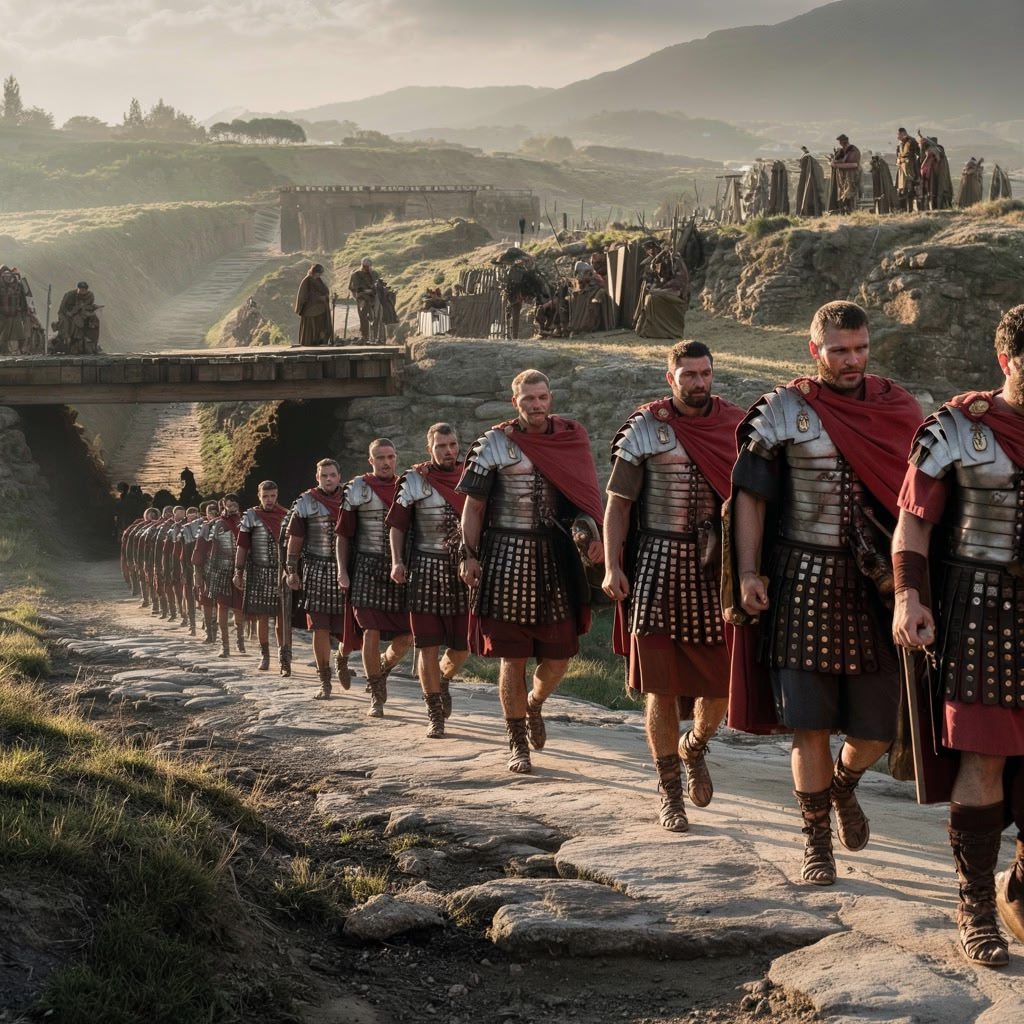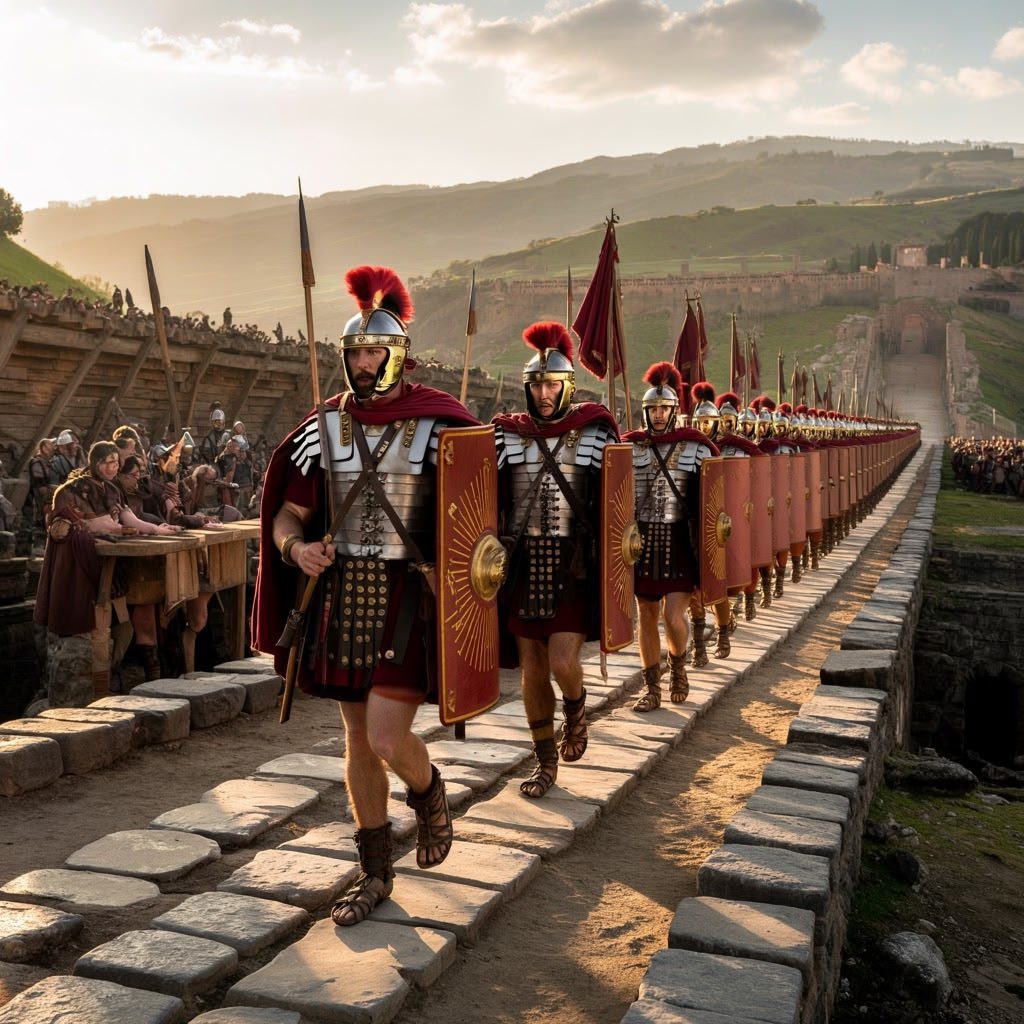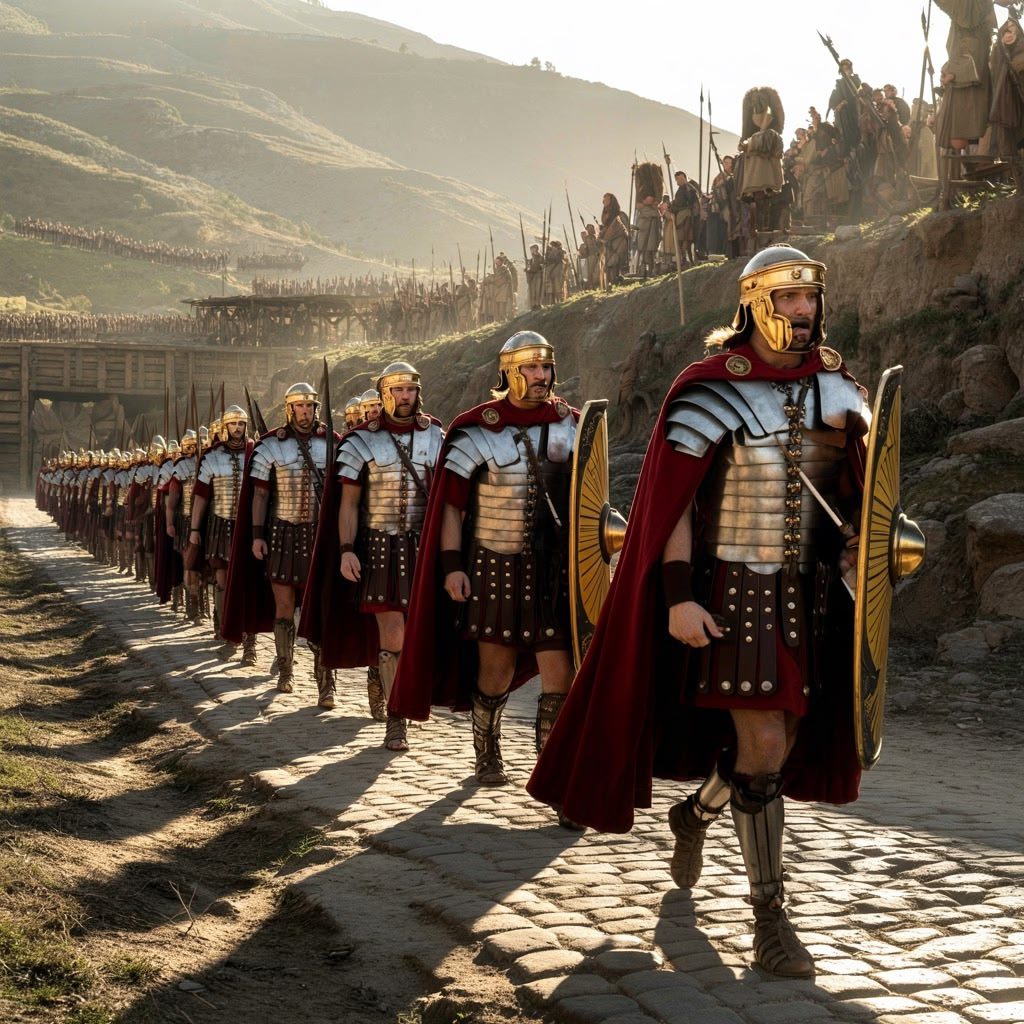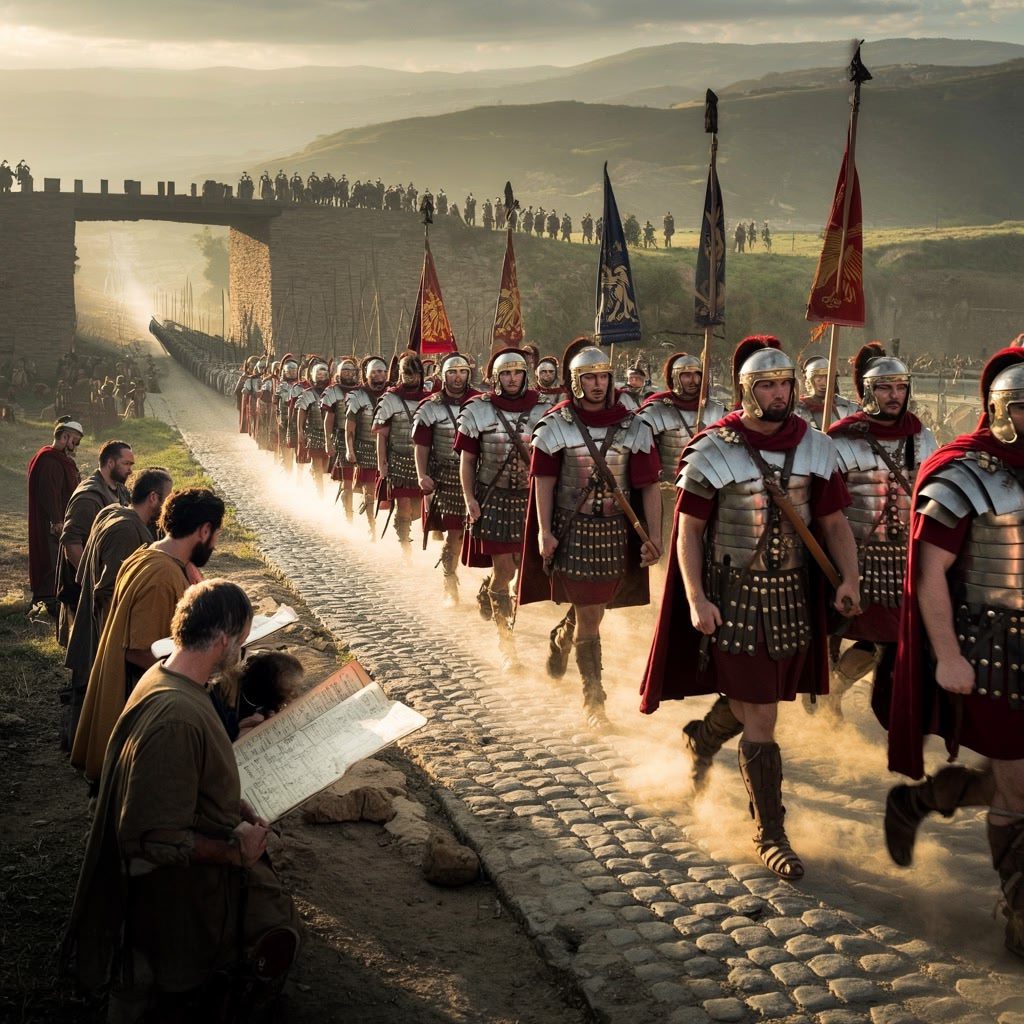The thunderous approach of Roman legions once sent enemies fleeing before a single javelin was thrown. Two thousand years later, the strategic brilliance that built history’s greatest ancient empire continues to shape how nations wage war—often without recognition or acknowledgment. While popular culture celebrates Roman gladiators and emperors, the revolutionary military systems that truly powered Rome’s dominance remain hidden in plain sight on modern battlefields from Afghanistan to Ukraine.
When most people think of Roman military might, they envision shield walls and short swords—the superficial trappings of warfare. This fundamental misunderstanding obscures what made Rome truly exceptional: not just its weapons, but its comprehensive systems of command, control, logistics, and psychological operations that created an adaptable fighting force unlike anything the ancient world had seen before.
Today’s military commanders from West Point to Sandhurst still study these ancient principles, adapting Roman innovations to modern technology. The disconnect between what we think we know about Roman warfare and its actual, lasting impact represents a critical gap in understanding how military strategy has evolved—and why certain approaches remain effective across millennia.
What follows is an examination of the military genius that still echoes through time—strategic principles first codified by Roman generals that continue to influence modern military doctrine, often without attribution or recognition. The strategic DNA of Rome’s legions lives on in today’s armed forces, offering timeless lessons in how to achieve victory through more than mere force of arms.
The Grand Strategy: Roman “Flexible Response” and Modern Military Adaptation
Rome’s most enduring military innovation wasn’t a weapon or formation, but a strategic concept: flexible response. Unlike their contemporaries who often relied on a single approach to warfare, Roman commanders developed a system that could adapt to any enemy or terrain. This flexibility stemmed from their modular legion structure—cohorts of infantry supported by auxiliary forces that could be reconfigured based on mission requirements.
This same principle underpins modern military organization. The U.S. Army’s Brigade Combat Team structure, developed in the early 2000s, follows remarkably similar organizational logic—self-contained fighting units that can operate independently or as part of larger formations. Both systems create what military planners call “tailored force packages” that can be scaled and adapted to different conflict types.
When American forces entered Iraq in 2003, they initially deployed with heavy armor suited for conventional warfare. As the conflict evolved into counterinsurgency, the military reconfigured into smaller, more mobile units better suited for urban operations and population security. This mirrors how Roman legions would shift from heavy infantry configurations when fighting Gallic tribes to lighter, more mobile formations when campaigning against Parthian horsemen.
The flexible response doctrine extends beyond unit organization. Roman commanders understood that warfare required different approaches depending on the strategic context—sometimes pursuing decisive battle, other times employing scorched earth tactics, economic pressure, or diplomatic isolation. This multi-domain approach to warfare has become central to modern military thinking.
What makes this strategic flexibility so enduring is that it acknowledges a fundamental truth: warfare isn’t static. Enemies adapt, technologies change, and political objectives evolve. Military organizations that build adaptability into their core structure—as Rome did—maintain advantages over more rigid opponents. This principle has proven as valuable in countering insurgencies in the digital age as it was in subduing Celtic tribes two millennia ago.

Engineering Dominance: From Roman Roads to Modern Military Infrastructure
The Roman legionary wasn’t just a soldier—he was also an engineer. Roman military engineering transformed warfare, creating infrastructure that served both tactical and strategic purposes. The most famous example remains their road network—over 250,000 miles of engineered roads that allowed rapid troop movements across the empire.
These weren’t merely travel routes; they were strategic assets. Roman roads were designed to specific widths that accommodated marching formations, with surfaces engineered to remain passable in all weather conditions. Milestones provided precise distance measurements, allowing commanders to plan movements with unprecedented accuracy. The entire system enabled what modern military planners call “operational maneuver”—the ability to position forces rapidly where they can have decisive impact.
This integration of engineering into military operations continues today. During Operation Desert Storm in 1991, U.S. Army Engineers constructed over 500 kilometers of combat roads and breached complex Iraqi defensive obstacles to enable the ground offensive. In Afghanistan, military engineers built hundreds of forward operating bases and combat outposts, often in remote mountain terrain—echoing how Roman legions established fortified camps even during single-night stays on campaign.
Beyond roads, Roman military engineering included sophisticated bridging capabilities. Julius Caesar’s Rhine River bridge, built in just ten days, demonstrated how engineering could overcome natural barriers that enemies considered impassable. Modern military bridging units maintain this tradition, deploying rapidly-assembled pontoon systems that can support heavy armor crossing rivers under combat conditions.
The Roman approach to field fortifications also lives on in modern doctrine. The daily practice of constructing marching camps—temporary fortifications built at the end of each day’s march—established a defensive mindset that continues in modern operations. Today’s combat outposts follow similar principles: standardized designs adapted to local terrain, constructed rapidly with available materials, and configured to maximize defensive advantages.
What makes Roman military engineering so influential is its integration into overall military thinking. Engineering wasn’t separate from combat operations—it was an essential component of how Rome projected power. This holistic approach to military capability remains fundamental to modern armed forces, where combat engineering continues to create conditions for battlefield success.
Psychological Warfare: Rome’s Invisible Weapon
Roman legions conquered as much through fear as through actual combat. The psychological dimension of Roman warfare represented a sophisticated understanding that breaking an enemy’s will to fight often proved more effective than breaking their formations. This psychological approach operated on multiple levels—from the individual soldier to entire populations.
At its most visible, Roman psychological warfare manifested in the legions’ distinctive appearance and sound. The uniformity of equipment, synchronized movements, and the distinctive sound of thousands of hobnailed boots striking the ground created what behavioral psychologists now call “captivation”—a sensory experience that triggers fear and awe. Modern militaries employ similar effects through precision drill, aircraft flyovers, and the distinctive sound signatures of vehicles like the A-10 Warthog, whose GAU-8 cannon produces a psychological effect beyond its physical destruction.
More subtly, Romans practiced what we now call “information operations.” They carefully managed narratives about their military power, ensuring stories of Roman victory and retribution spread to potential adversaries. Caesar’s Commentaries on the Gallic War weren’t merely historical records—they were strategic communication designed to shape perceptions of Roman power. Similarly, modern military operations include strategic communication components designed to influence key audiences and shape the information environment.
Roman commanders also understood the power of demonstrated resolve. When facing the Carthaginian threat, Cato the Elder concluded every speech in the Senate with “Carthago delenda est”—”Carthage must be destroyed.” This single-minded messaging signaled unwavering determination. Modern military powers employ similar approaches, as when the United States adopted the “Bush Doctrine” after 9/11, making clear that America would make no distinction between terrorists and nations harboring them.
Perhaps most significantly, Rome mastered the balance between punishment and integration. Enemies who submitted received pathways to citizenship and prosperity within the Roman system. Those who resisted faced overwhelming force. This created powerful incentives for cooperation. Modern counterinsurgency doctrine, particularly the “clear, hold, build” approach, echoes this Roman principle—combining security operations with governance and development to provide alternatives to resistance.
The psychological dimension of warfare has only grown more important in an interconnected world where battles for perception often matter more than physical terrain. Rome’s sophisticated understanding that warfare occurs in the mind as much as on the battlefield represents one of its most enduring military contributions.

Logistics: The Roman Supply Revolution
Military historians often cite Napoleon’s observation that “an army marches on its stomach.” Yet it was Rome that first systematized military logistics on a grand scale, creating supply networks that sustained operations across three continents. This logistical revolution provided Rome with operational endurance that opponents simply couldn’t match.
The Roman military supply system functioned through a network of fortified supply depots, standardized rations, and precise calculations of consumption rates. Legion quartermasters maintained detailed records tracking everything from grain to replacement javelin shafts. This administrative precision allowed Roman forces to operate at distances and durations that would have crippled other ancient armies.
Modern military logistics directly descends from this Roman innovation. During Operation Iraqi Freedom, the U.S. military’s logistics system tracked millions of supply items moving through a global network of bases and depots. The Defense Logistics Agency, with its vast computer networks and standardized supply classifications, would be recognizable in concept to a Roman quartermaster, even if the technology has advanced.
Roman armies also pioneered what we now call “foraging doctrine”—systematic approaches to obtaining supplies from the operational environment. Rather than random plundering, Roman forces conducted organized collection operations with specific targets and quantities. This disciplined approach to local resourcing remains part of modern military logistics planning, particularly for special operations forces that may need to operate without established supply lines.
Perhaps most importantly, Rome recognized logistics as a strategic capability, not merely an administrative function. Control of sea lanes, granaries, and key production regions factored into campaign planning at the highest levels. This strategic approach to supply continues today, with military planners considering global supply chains, prepositioning of equipment, and resource security as fundamental aspects of national defense.
The enduring lesson from Rome’s logistical system is that sustained military power requires more than fighting ability—it requires systems that can reliably deliver resources where and when needed. As modern militaries confront global supply chain vulnerabilities and contested logistics environments, the Roman approach to self-sufficient, administratively precise supply management offers enduring lessons.
Combined Arms Warfare: Integration Before Technology
Modern combined arms doctrine—the synchronized employment of infantry, armor, artillery, and air power—is often attributed to 20th-century innovations. Yet the fundamental concept of integrating complementary military capabilities originated with the Romans, who mastered what we now call “combined arms warfare” long before the advent of modern technology.
The Roman legion represented the ancient world’s most sophisticated combined arms system. Heavy infantry formed the core, but operated in coordination with velites (light skirmishers), equites (cavalry), and various specialized units including slingers and archers. Each element had distinct capabilities and vulnerabilities, but together created a whole greater than the sum of its parts.
This integration allowed Rome to execute complex battlefield maneuvers. At Ilipa in 206 BCE, Scipio Africanus employed a double envelopment, using his infantry to fix the Carthaginian center while cavalry and light troops enveloped both flanks. This same basic maneuver appears in modern military doctrine, most famously in Operation Desert Storm, where coalition ground forces fixed Iraqi units along the Kuwait border while mobile forces executed a massive flanking movement.
Roman combined arms thinking extended beyond the tactical level. They understood that different types of military power—land forces, naval power, siege capabilities, and diplomatic pressure—could be coordinated to achieve strategic effects. This comprehensive approach to military operations foreshadowed modern concepts of joint operations and interagency coordination.
The success of combined arms doctrine rests on a fundamental insight: warfare presents complex problems that single-capability forces cannot solve alone. Infantry needs mobility and firepower support; armor needs infantry protection in complex terrain; both need logistics and intelligence support. By integrating these complementary capabilities, commanders can create dilemmas for adversaries that have no good solutions.
This principle remains at the heart of modern military operations. When U.S. forces entered urban combat in Iraq, they integrated infantry, armor, aviation, and intelligence capabilities to address the multifaceted challenges of city fighting. The underlying concept—that different military capabilities must work in coordinated fashion—would be immediately recognizable to Roman commanders who integrated their own varied force elements two millennia earlier.

Professional Military Education: The Roman Tradition of Learned Warriors
Perhaps Rome’s most significant yet least recognized military innovation was the institutionalization of professional military knowledge. Unlike many contemporaries who relied on individual talent or aristocratic tradition, Rome created systems to develop, record, and transmit military expertise across generations of commanders.
Roman military education combined practical experience with theoretical knowledge. Junior officers learned through a combination of mentorship from senior commanders, personal study of military texts, and progressive responsibility in actual operations. This combination of theory and practice created versatile leaders capable of independent command.
This approach directly influenced modern professional military education. Today’s war colleges and command staff schools follow remarkably similar principles—combining historical case studies, theoretical frameworks, and practical exercises to develop military judgment. When officers at the U.S. Army Command and General Staff College study historical campaigns and principles of war, they participate in an educational tradition with direct links to Roman practice.
The Romans also pioneered the concept of after-action reviews and lessons learned. Campaigns were systematically analyzed to identify successes and failures, with insights incorporated into future operations. This institutionalized learning process created an evolving body of military knowledge that accumulated across centuries. Modern militaries maintain similar systems, from the U.S. Army’s Center for Army Lessons Learned to NATO’s Joint Analysis and Lessons Learned Centre.
Beyond formal education, Rome created a culture of professional reading and discussion among its officer corps. Military treatises like Vegetius’s “De Re Militari” circulated widely among commanders, creating a common language and framework for military problems. This tradition continues in modern military reading lists and professional journals that foster ongoing intellectual development throughout military careers.
The enduring impact of Rome’s approach to military education lies in its recognition that warfare requires more than courage or strength—it demands systematic study and intellectual development. As warfare grows increasingly complex, the Roman tradition of developing thoughtful, educated military leaders becomes ever more relevant.

The Strategic Legacy: Why Roman Military Thinking Endures
What explains the remarkable staying power of Roman military concepts across two millennia? The answer lies not in specific weapons or tactics, but in Rome’s revolutionary approach to warfare as a systematic, institutionalized activity rather than merely an expression of valor or leadership.
Rome approached warfare as a problem to be solved through organization, training, engineering, psychology, and logistics—not merely through combat prowess. This comprehensive perspective created military capabilities that transcended individual battles to establish sustainable strategic advantages. Modern military powers, regardless of their political systems or cultural backgrounds, have repeatedly rediscovered the effectiveness of this systematic approach.
The Roman military system also succeeded because it integrated tactical excellence with strategic purpose. Battlefield victories translated into political outcomes through well-developed systems of occupation, governance, and cultural integration. This alignment between military operations and strategic objectives remains the fundamental challenge of modern warfare, where tactical success without strategic framework often leads to indecisive or counterproductive outcomes.
Perhaps most importantly, Roman military thinking demonstrated remarkable adaptability. Over centuries, Rome’s military system absorbed innovations from defeated enemies, adapted to new challenges, and evolved its doctrine while maintaining core principles. This balance between innovation and continuity allowed Roman military effectiveness to span centuries rather than decades.
As modern military organizations navigate accelerating technological change and evolving threat environments, the Roman capacity for systematic adaptation offers a valuable model. The fundamental challenge remains consistent across time: how to develop military systems that can prevail across diverse operational contexts while advancing strategic objectives.
For contemporary military professionals and national security leaders, Rome’s military legacy provides not just historical interest but practical insight. The principles that allowed Rome to project power, sustain operations, and integrate military success with political objectives remain relevant in an age of drones, cyber warfare, and information operations. Beneath the technological surface, the fundamental challenges of warfare remain remarkably consistent—and Rome’s systematic solutions continue to inform how these challenges are addressed.
Reflection Questions: Ancient Wisdom for Modern Challenges
How might Roman approaches to flexibility and adaptation inform military responses to hybrid warfare and gray zone conflicts that don’t fit neatly into traditional categories of peace and war? What could modern military organizations learn from Rome’s integration of engineering into core military capabilities when addressing challenges like climate change or pandemic response? In what ways might Rome’s systematic approach to military education inform how we develop leaders capable of operating in complex, ambiguous environments?
The enduring relevance of Roman military thinking reminds us that beneath the technological trappings of warfare lie fundamental challenges of organization, psychology, and strategic purpose that transcend time. By recognizing and studying these continuities, modern military thinkers can access not just historical curiosities but practical wisdom tested across centuries of conflict.
The forgotten generals of Rome—innovative commanders whose names may be less familiar than Caesar or Alexander but whose systemic innovations proved more lasting—created not just victories but frameworks for victory that continue to shape how modern armies fight and win. Their legacy lives on whenever military organizations approach warfare as a challenge requiring not just courage but comprehensive, systematic thinking about how to apply power in pursuit of lasting objectives.

